Implementing Asthma Management in Schools through Nursing Leadership
VerifiedAdded on 2020/04/21
|7
|1041
|269
AI Summary
This document presents an implementation plan devised for the Harris Health Organization, targeting a reduction in asthma-related clinic visits among schoolchildren. It involves three nurses visiting five schools and executing interventions tailored towards children with asthma over six months. The intervention leverages both primary and secondary data collection, employing quantitative analysis tools like SPSS software to assess outcomes. Various strategies including education on environmental hygiene and awareness about hypersensitivity are proposed for parents, aiming at reducing asthmatic episodes. Potential barriers such as lack of participant willingness and resource constraints are addressed, with emphasis placed on engaging participants through detailed explanations of the research's importance.
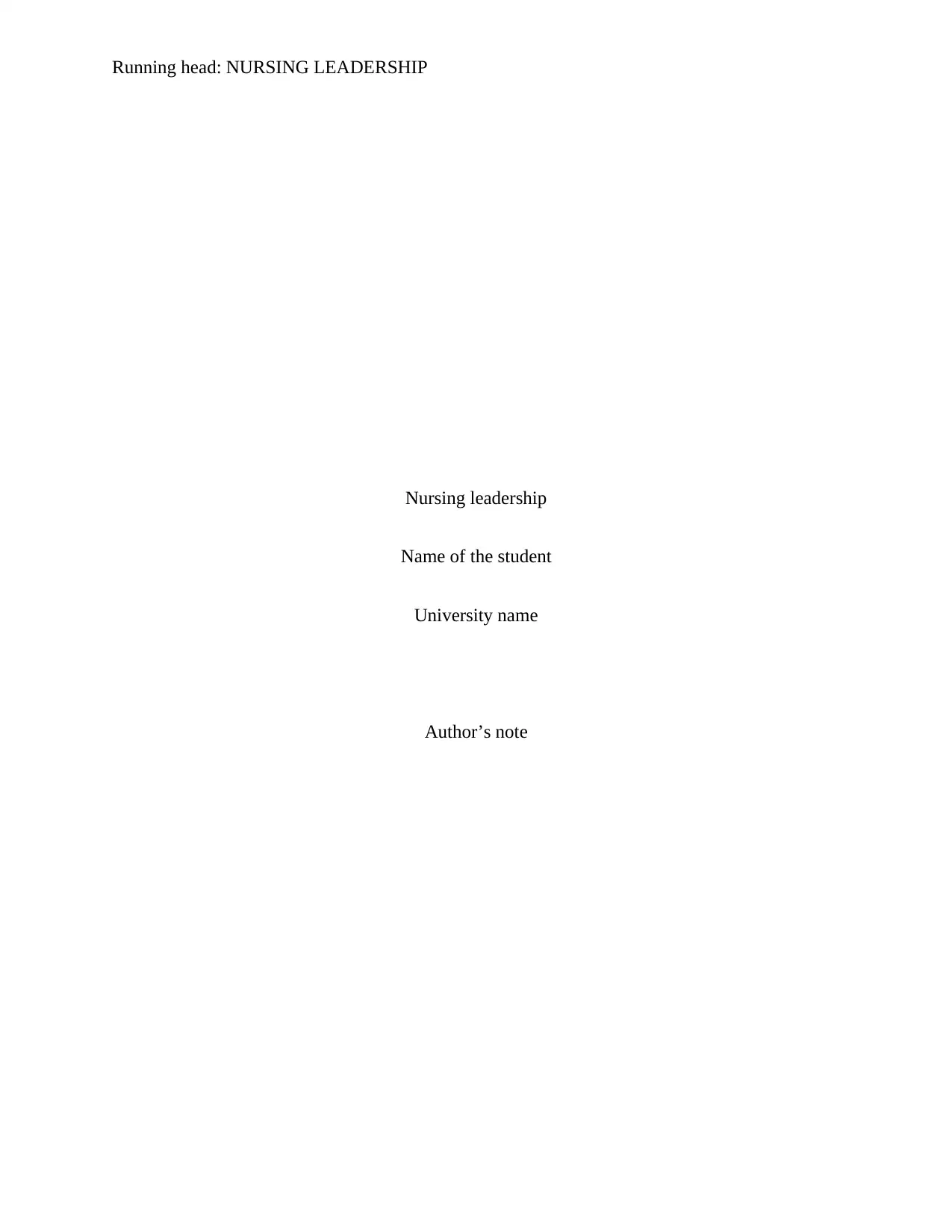
Running head: NURSING LEADERSHIP
Nursing leadership
Name of the student
University name
Author’s note
Nursing leadership
Name of the student
University name
Author’s note
Paraphrase This Document
Need a fresh take? Get an instant paraphrase of this document with our AI Paraphraser
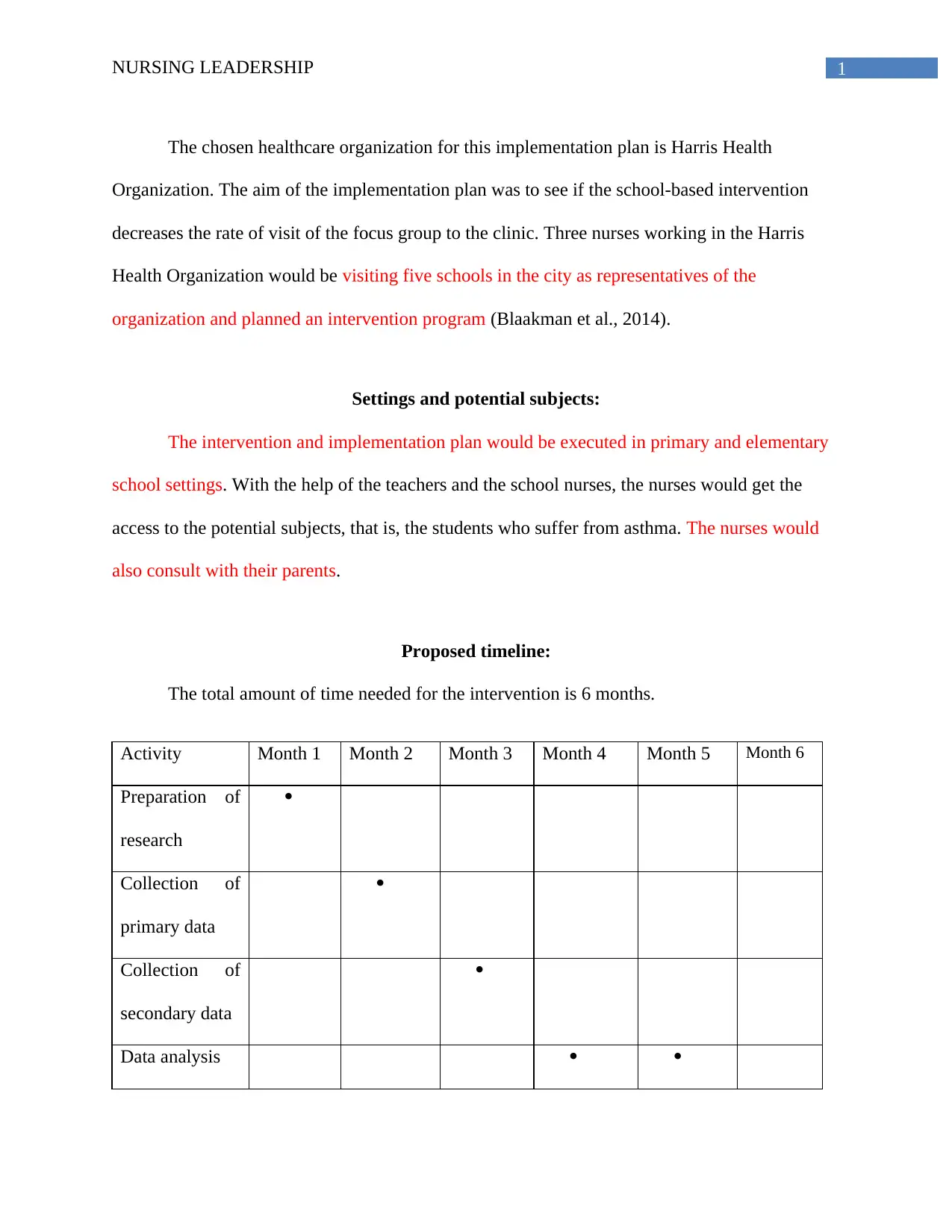
1NURSING LEADERSHIP
The chosen healthcare organization for this implementation plan is Harris Health
Organization. The aim of the implementation plan was to see if the school-based intervention
decreases the rate of visit of the focus group to the clinic. Three nurses working in the Harris
Health Organization would be visiting five schools in the city as representatives of the
organization and planned an intervention program (Blaakman et al., 2014).
Settings and potential subjects:
The intervention and implementation plan would be executed in primary and elementary
school settings. With the help of the teachers and the school nurses, the nurses would get the
access to the potential subjects, that is, the students who suffer from asthma. The nurses would
also consult with their parents.
Proposed timeline:
The total amount of time needed for the intervention is 6 months.
Activity Month 1 Month 2 Month 3 Month 4 Month 5 Month 6
Preparation of
research
Collection of
primary data
Collection of
secondary data
Data analysis
The chosen healthcare organization for this implementation plan is Harris Health
Organization. The aim of the implementation plan was to see if the school-based intervention
decreases the rate of visit of the focus group to the clinic. Three nurses working in the Harris
Health Organization would be visiting five schools in the city as representatives of the
organization and planned an intervention program (Blaakman et al., 2014).
Settings and potential subjects:
The intervention and implementation plan would be executed in primary and elementary
school settings. With the help of the teachers and the school nurses, the nurses would get the
access to the potential subjects, that is, the students who suffer from asthma. The nurses would
also consult with their parents.
Proposed timeline:
The total amount of time needed for the intervention is 6 months.
Activity Month 1 Month 2 Month 3 Month 4 Month 5 Month 6
Preparation of
research
Collection of
primary data
Collection of
secondary data
Data analysis
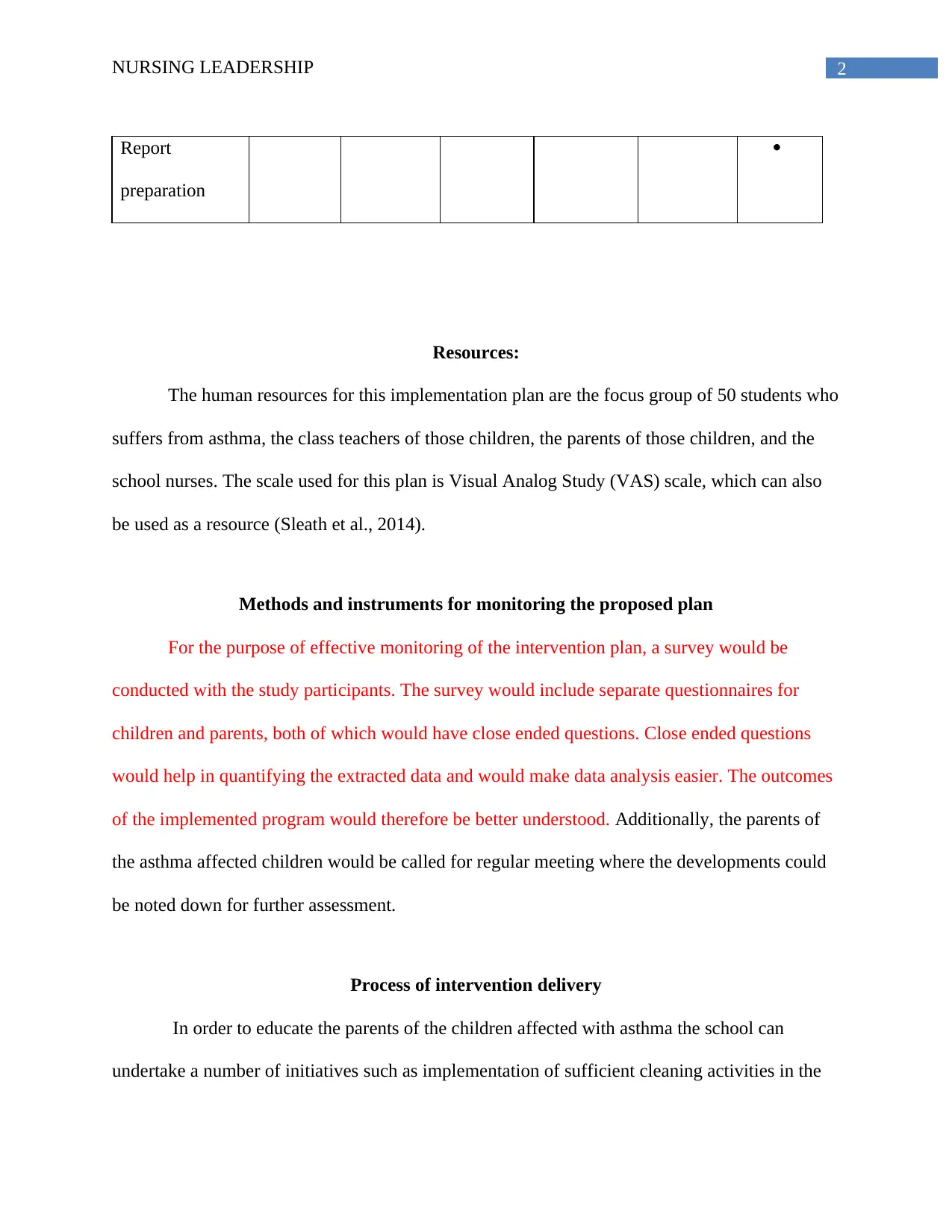
2NURSING LEADERSHIP
Report
preparation
Resources:
The human resources for this implementation plan are the focus group of 50 students who
suffers from asthma, the class teachers of those children, the parents of those children, and the
school nurses. The scale used for this plan is Visual Analog Study (VAS) scale, which can also
be used as a resource (Sleath et al., 2014).
Methods and instruments for monitoring the proposed plan
For the purpose of effective monitoring of the intervention plan, a survey would be
conducted with the study participants. The survey would include separate questionnaires for
children and parents, both of which would have close ended questions. Close ended questions
would help in quantifying the extracted data and would make data analysis easier. The outcomes
of the implemented program would therefore be better understood. Additionally, the parents of
the asthma affected children would be called for regular meeting where the developments could
be noted down for further assessment.
Process of intervention delivery
In order to educate the parents of the children affected with asthma the school can
undertake a number of initiatives such as implementation of sufficient cleaning activities in the
Report
preparation
Resources:
The human resources for this implementation plan are the focus group of 50 students who
suffers from asthma, the class teachers of those children, the parents of those children, and the
school nurses. The scale used for this plan is Visual Analog Study (VAS) scale, which can also
be used as a resource (Sleath et al., 2014).
Methods and instruments for monitoring the proposed plan
For the purpose of effective monitoring of the intervention plan, a survey would be
conducted with the study participants. The survey would include separate questionnaires for
children and parents, both of which would have close ended questions. Close ended questions
would help in quantifying the extracted data and would make data analysis easier. The outcomes
of the implemented program would therefore be better understood. Additionally, the parents of
the asthma affected children would be called for regular meeting where the developments could
be noted down for further assessment.
Process of intervention delivery
In order to educate the parents of the children affected with asthma the school can
undertake a number of initiatives such as implementation of sufficient cleaning activities in the
⊘ This is a preview!⊘
Do you want full access?
Subscribe today to unlock all pages.

Trusted by 1+ million students worldwide
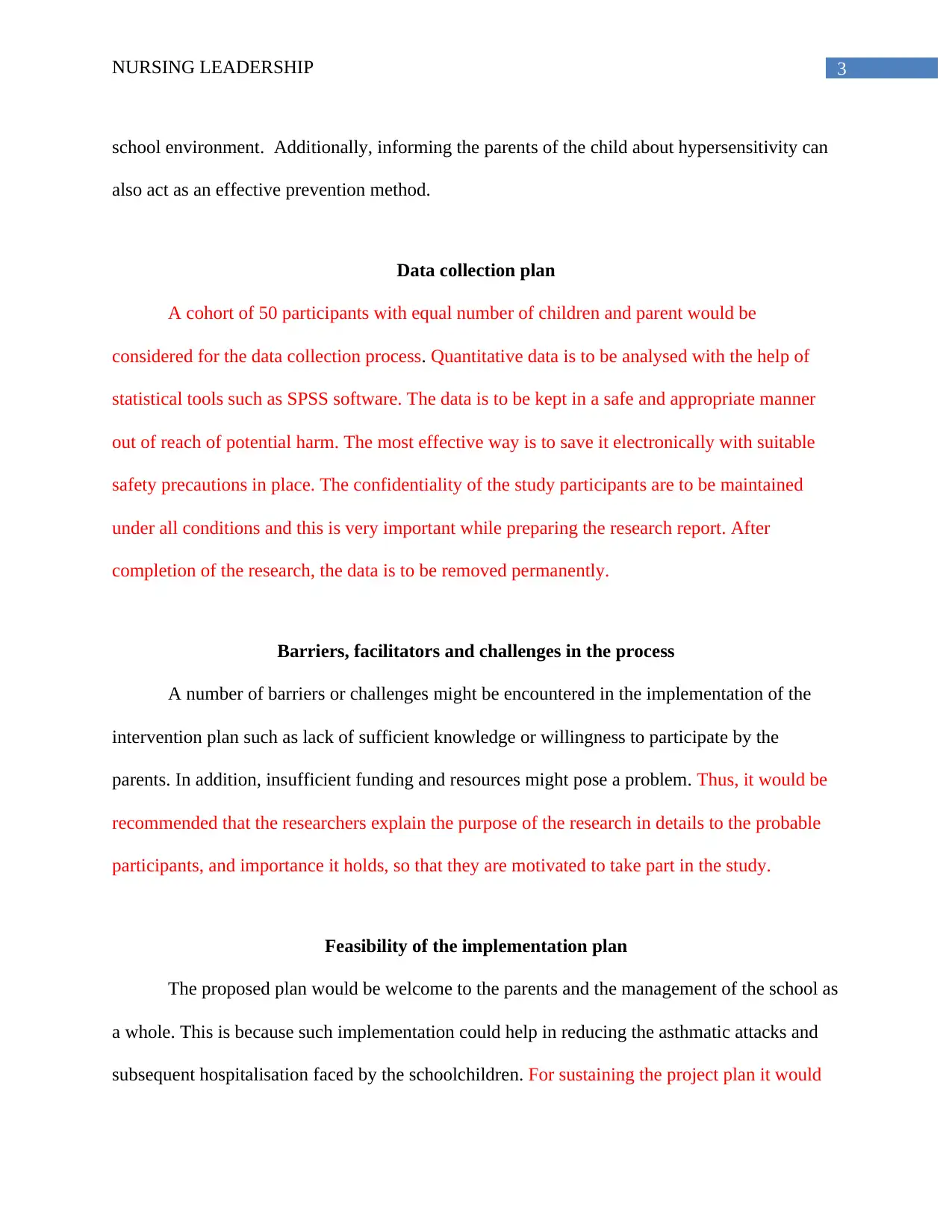
3NURSING LEADERSHIP
school environment. Additionally, informing the parents of the child about hypersensitivity can
also act as an effective prevention method.
Data collection plan
A cohort of 50 participants with equal number of children and parent would be
considered for the data collection process. Quantitative data is to be analysed with the help of
statistical tools such as SPSS software. The data is to be kept in a safe and appropriate manner
out of reach of potential harm. The most effective way is to save it electronically with suitable
safety precautions in place. The confidentiality of the study participants are to be maintained
under all conditions and this is very important while preparing the research report. After
completion of the research, the data is to be removed permanently.
Barriers, facilitators and challenges in the process
A number of barriers or challenges might be encountered in the implementation of the
intervention plan such as lack of sufficient knowledge or willingness to participate by the
parents. In addition, insufficient funding and resources might pose a problem. Thus, it would be
recommended that the researchers explain the purpose of the research in details to the probable
participants, and importance it holds, so that they are motivated to take part in the study.
Feasibility of the implementation plan
The proposed plan would be welcome to the parents and the management of the school as
a whole. This is because such implementation could help in reducing the asthmatic attacks and
subsequent hospitalisation faced by the schoolchildren. For sustaining the project plan it would
school environment. Additionally, informing the parents of the child about hypersensitivity can
also act as an effective prevention method.
Data collection plan
A cohort of 50 participants with equal number of children and parent would be
considered for the data collection process. Quantitative data is to be analysed with the help of
statistical tools such as SPSS software. The data is to be kept in a safe and appropriate manner
out of reach of potential harm. The most effective way is to save it electronically with suitable
safety precautions in place. The confidentiality of the study participants are to be maintained
under all conditions and this is very important while preparing the research report. After
completion of the research, the data is to be removed permanently.
Barriers, facilitators and challenges in the process
A number of barriers or challenges might be encountered in the implementation of the
intervention plan such as lack of sufficient knowledge or willingness to participate by the
parents. In addition, insufficient funding and resources might pose a problem. Thus, it would be
recommended that the researchers explain the purpose of the research in details to the probable
participants, and importance it holds, so that they are motivated to take part in the study.
Feasibility of the implementation plan
The proposed plan would be welcome to the parents and the management of the school as
a whole. This is because such implementation could help in reducing the asthmatic attacks and
subsequent hospitalisation faced by the schoolchildren. For sustaining the project plan it would
Paraphrase This Document
Need a fresh take? Get an instant paraphrase of this document with our AI Paraphraser
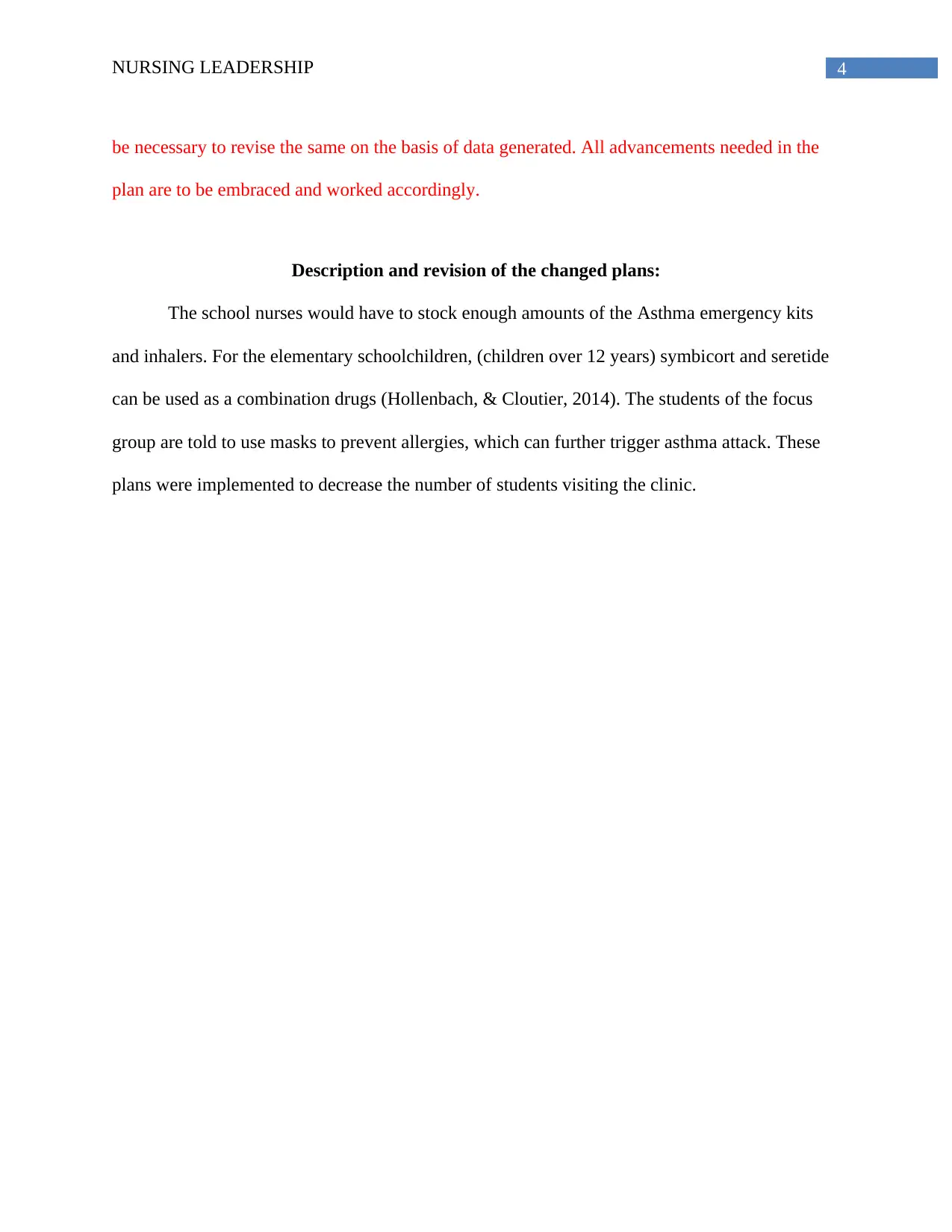
4NURSING LEADERSHIP
be necessary to revise the same on the basis of data generated. All advancements needed in the
plan are to be embraced and worked accordingly.
Description and revision of the changed plans:
The school nurses would have to stock enough amounts of the Asthma emergency kits
and inhalers. For the elementary schoolchildren, (children over 12 years) symbicort and seretide
can be used as a combination drugs (Hollenbach, & Cloutier, 2014). The students of the focus
group are told to use masks to prevent allergies, which can further trigger asthma attack. These
plans were implemented to decrease the number of students visiting the clinic.
be necessary to revise the same on the basis of data generated. All advancements needed in the
plan are to be embraced and worked accordingly.
Description and revision of the changed plans:
The school nurses would have to stock enough amounts of the Asthma emergency kits
and inhalers. For the elementary schoolchildren, (children over 12 years) symbicort and seretide
can be used as a combination drugs (Hollenbach, & Cloutier, 2014). The students of the focus
group are told to use masks to prevent allergies, which can further trigger asthma attack. These
plans were implemented to decrease the number of students visiting the clinic.
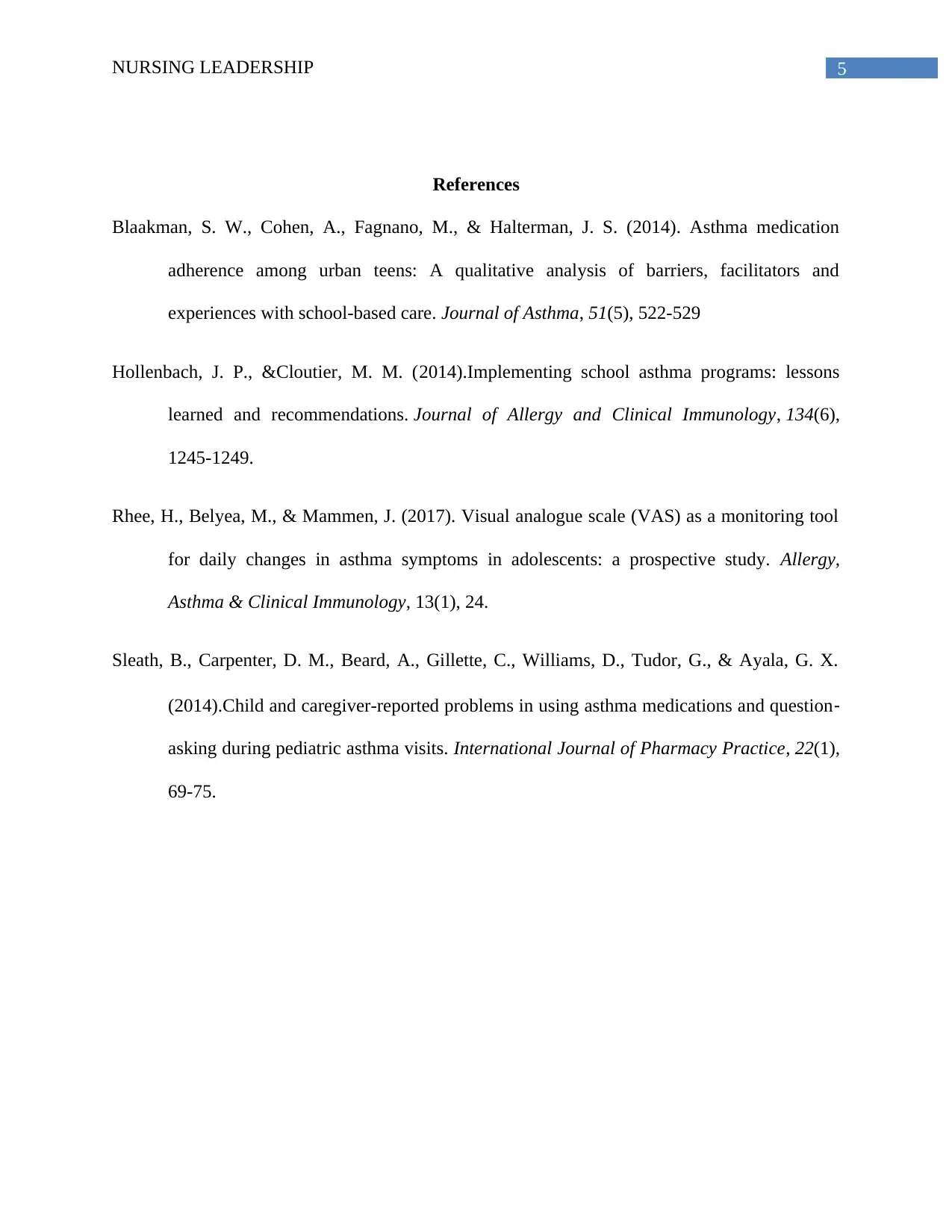
5NURSING LEADERSHIP
References
Blaakman, S. W., Cohen, A., Fagnano, M., & Halterman, J. S. (2014). Asthma medication
adherence among urban teens: A qualitative analysis of barriers, facilitators and
experiences with school-based care. Journal of Asthma, 51(5), 522-529
Hollenbach, J. P., &Cloutier, M. M. (2014).Implementing school asthma programs: lessons
learned and recommendations. Journal of Allergy and Clinical Immunology, 134(6),
1245-1249.
Rhee, H., Belyea, M., & Mammen, J. (2017). Visual analogue scale (VAS) as a monitoring tool
for daily changes in asthma symptoms in adolescents: a prospective study. Allergy,
Asthma & Clinical Immunology, 13(1), 24.
Sleath, B., Carpenter, D. M., Beard, A., Gillette, C., Williams, D., Tudor, G., & Ayala, G. X.
(2014).Child and caregiver-reported problems in using asthma medications and question‐
asking during pediatric asthma visits. International Journal of Pharmacy Practice, 22(1),
69-75.
References
Blaakman, S. W., Cohen, A., Fagnano, M., & Halterman, J. S. (2014). Asthma medication
adherence among urban teens: A qualitative analysis of barriers, facilitators and
experiences with school-based care. Journal of Asthma, 51(5), 522-529
Hollenbach, J. P., &Cloutier, M. M. (2014).Implementing school asthma programs: lessons
learned and recommendations. Journal of Allergy and Clinical Immunology, 134(6),
1245-1249.
Rhee, H., Belyea, M., & Mammen, J. (2017). Visual analogue scale (VAS) as a monitoring tool
for daily changes in asthma symptoms in adolescents: a prospective study. Allergy,
Asthma & Clinical Immunology, 13(1), 24.
Sleath, B., Carpenter, D. M., Beard, A., Gillette, C., Williams, D., Tudor, G., & Ayala, G. X.
(2014).Child and caregiver-reported problems in using asthma medications and question‐
asking during pediatric asthma visits. International Journal of Pharmacy Practice, 22(1),
69-75.
⊘ This is a preview!⊘
Do you want full access?
Subscribe today to unlock all pages.

Trusted by 1+ million students worldwide
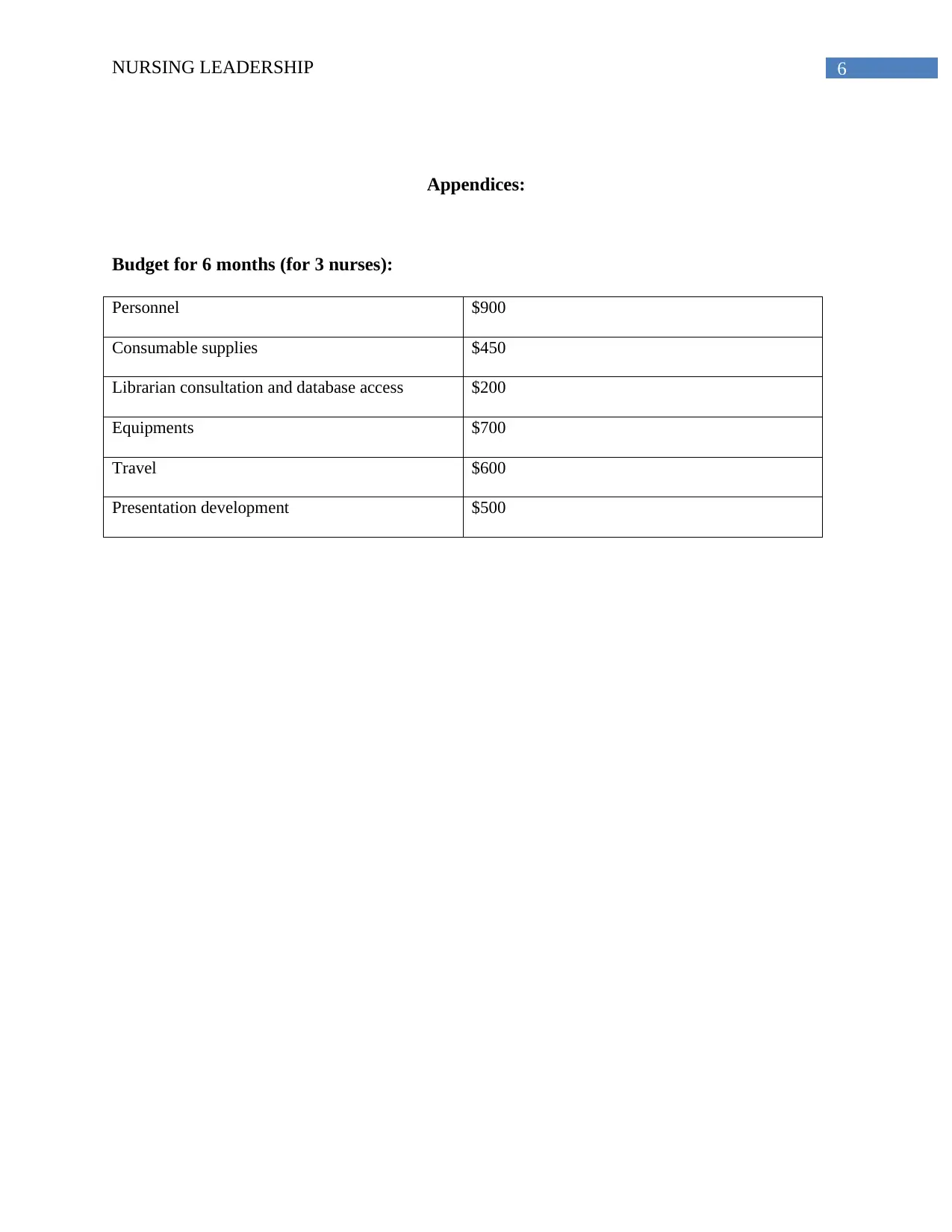
6NURSING LEADERSHIP
Appendices:
Budget for 6 months (for 3 nurses):
Personnel $900
Consumable supplies $450
Librarian consultation and database access $200
Equipments $700
Travel $600
Presentation development $500
Appendices:
Budget for 6 months (for 3 nurses):
Personnel $900
Consumable supplies $450
Librarian consultation and database access $200
Equipments $700
Travel $600
Presentation development $500
1 out of 7
Related Documents
Your All-in-One AI-Powered Toolkit for Academic Success.
+13062052269
info@desklib.com
Available 24*7 on WhatsApp / Email
![[object Object]](/_next/static/media/star-bottom.7253800d.svg)
Unlock your academic potential
Copyright © 2020–2025 A2Z Services. All Rights Reserved. Developed and managed by ZUCOL.




